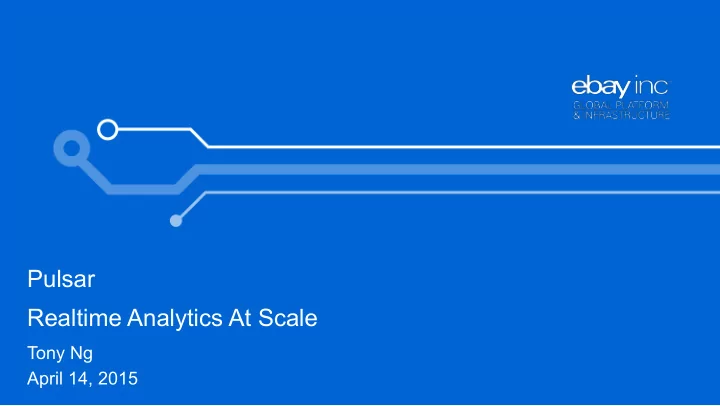

Pulsar Realtime Analytics At Scale Tony Ng April 14, 2015
Big Data Trends • Bigger data volumes • More data sources – DBs, logs, behavioral & business event streams, sensors … • Faster analysis – Next day to hours to minutes to seconds • Newer processing models – MR, in-memory, stream processing, Lambda … 2
What is Pulsar Open-source real-time analytics platform and stream processing framework 3
Business Needs for Real-time Analytics • Near real-time insights • React to user activities or events within seconds • Examples: – Real-time reporting and dashboards Optimize App Experience – Business activity monitoring – Personalization Analyze & Users – Marketing and advertising Generate Interact with Insights Apps – Fraud and bot detection Collect Events 4
Systemic Quality Requirements • Scalability – Scale to millions of events / sec • Latency – <1 sec delivery of events • Availability – No downtime during upgrades – Disaster recovery support across data centers • Flexibility – User driven complex processing rules – Declarative definition of pipeline topology and event routing • Data Accuracy – Should deal with missing data – 99.9% delivery guarantee 5
Pulsar Real-time Analytics Marketing In-memory compute cloud Personalization Behavioral Events Filter Dashboards Mutate Business Events Machine Learning Enrich Aggregate Security Risk Queries • Complex Event Processing (CEP) : SQL on stream data • Custom sub-stream creation: Filtering and Mutation • In Memory Aggregation: Multi Dimensional counting 6
Pulsar Framework Building Block (CEP Cell) Inbound Outbound Processor-1 Channel Channel-1 JVM Inbound Spring Container Processor-2 Channel-2 • Event = Tuples (K,V) – Mutable • Channels: Message, File, REST, Kafka, Custom • Event Processor: Esper, RateLimiter, RoundRobinLB, PartitionedLB, Custom 7
Pulsar Framework Flexibility • Stream Processing Pipeline – Consist of loosely coupled stages (cluster of CEP cells) – CEP cells (channels and processors) configured as Spring beans – Declarative wiring of CEP cells to define pipeline – Each stage can adopt its own release and deployment cycles – Support topology changes without pipeline restart • Stream Processing Logic – Two approaches: Java or SQL-like syntax through Esper integration – SQL statements can be hot deployed without restarting applications 8
Pulsar Real-time Analytics Pipeline 9
Complex Event Processing in Real-time Analytics Pipeline • Enrichment • Filtering and mutation • Analysis over windows of time (rolling vs. tumbling) – Aggregation – Grouping and ordering • Stateful processing • Integration with other systems 10
Event Filtering and Routing Example 11
Aggregate Computation Example 12
TopN Computation Example • TopN computation can be expensive with high cardinality dimensions • Consider approximate algorithms • Implemented as aggregate functions e.g. select ApproxTopN(10, D1, D2, D3) 13
Pulsar Deployment Architecture 14
Availability And Scalability • Self Healing • Datacenter failovers • State management • Shutdown Orchestration • Dynamic Partitioning • Elastic Clusters • Dynamic Flow Routing • Dynamic Topology Changes 15
Pulsar Integration with Kafka • Kafka – Persistent messaging queue – High availability, scalability and throughput • Pulsar leveraging Kafka – Supports pull and hybrid messaging model – Loading of data from real-time pipeline into Hadoop and other metric stores 16
Messaging Models Netty Consumer Producer Consumer Producer Push Model (At most once delivery semantics) Kafka Queue Pull Model Pause/Resume (At least once delivery semantics) Producer Consumer Kafka Replayer Queue Hybrid Model
Pulsar Integration with Kylin • Apache Kylin – Distributed analytics engine – Provide SQL interface and multi-dimensional analysis (OLAP) on Hadoop – Support extremely large datasets • Pulsar leveraging Kylin – Build multi-dimensional OLAP cube over long time period – Aggregate/drill-down on dimensions such as browser, OS, device, geo location – Capture metrics such as session length, page views, event counts 18
Pulsar Integration with Druid • Druid – Real-time ROLAP engine for aggregation, drill-down and slice-n-dice • Pulsar leveraging Druid – Real-time analytics dashboard – Near real-time metrics like number of visitors in the last 5 minutes, refreshing every 10 seconds – Aggregate/drill-down on dimensions such as browser, OS, device, geo location 19
Key Takeaways • Creating pipelines declaratively • SQL driven processing logic with hot deployment of SQL • Framework for custom SQL extensions • Dynamic partitioning and flow control • < 100 millisecond pipeline latency • 99.99% Availability • < 0.01% steady state data loss • Cloud deployable 20
Future Development and Open Source • Real-time reporting API and dashboard • Integration with Druid and other metrics stores • Session store scaling to 1 million insert/update per sec • Rolling window aggregation over long time windows (hours or days) • Dynamic Joins with graphs and RDBMS tables • Hot deployment of Java source code 21
More Information • GitHub: http://github.com/pulsarIO – repos: pipeline, framework, docker files • Website: http://gopulsar.io – Technical whitepaper – Getting started – Documentation • Google group: http://groups.google.com/d/forum/pulsar 22
Appendix
Twitter Storm/Spark Streaming vs Pulsar – Key Differences Requirement Pulsar Storm/Trident Spark Streaming Declarative Pipeline Wiring Yes No No Pipeline stitching Run time Build time Build time Topology change requires reboot No Yes Yes SQL support Yes No Yes* Hot deployment of processing rules Yes No No Guaranteed Message Processing Yes (batching) Yes Yes Pipeline Flow Control Yes ? ? Stateful Processing Yes Yes Yes 24
Recommend
More recommend